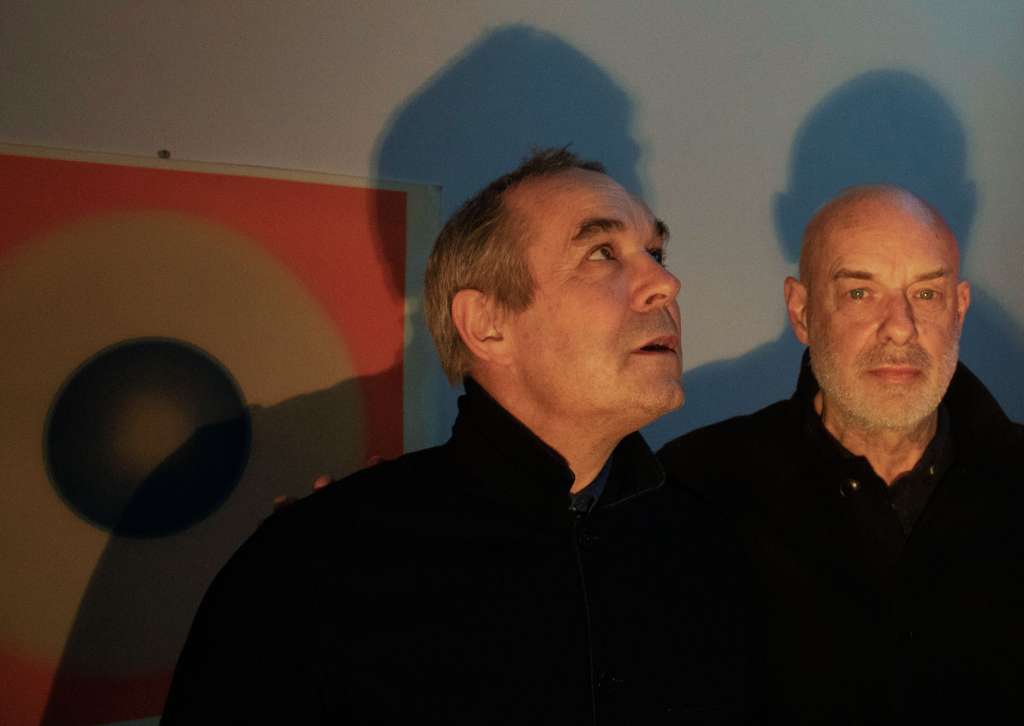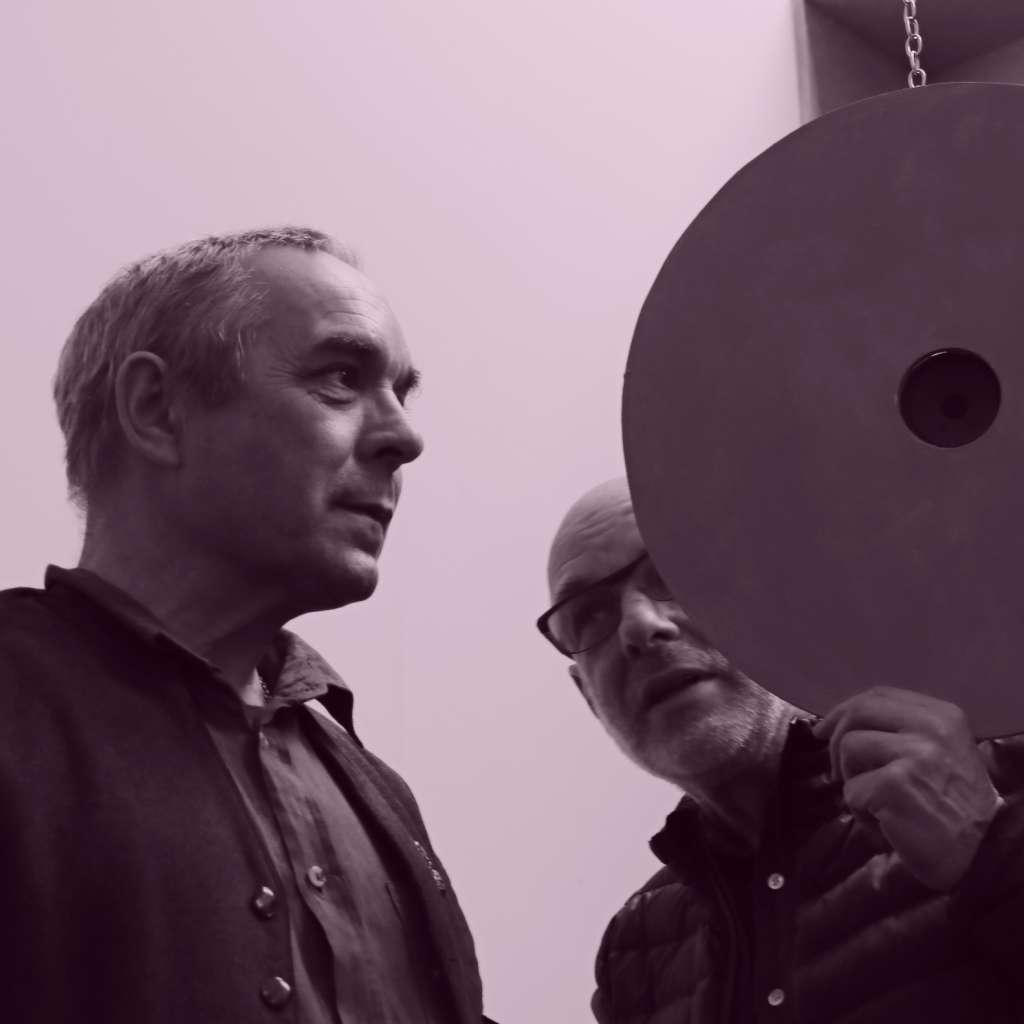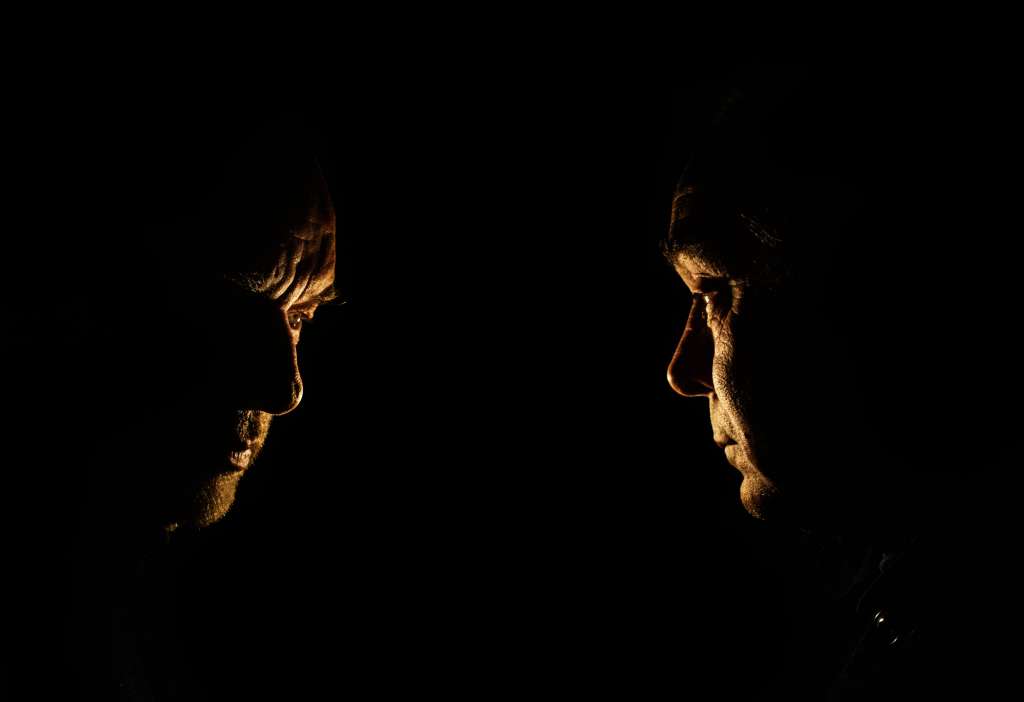Brothers Roger Eno & Brian Eno have been making music together since 1983. The brothers first joined forces, in collaboration with Daniel Lanois, to write and record For All Mankind, the soundtrack to Al Reinert’s epic documentary about the Apollo moon missions. Music from this soundtrack was released as the critically acclaimed and hugely popular album Apollo: Atmospheres & Soundtracks (1983). Further film work followed, including ‘Prophecy Theme’ for David Lynch’s Dune (1984), and a number of pieces used on the soundtrack to Dario Argento’s Opera (1987).
The name ‘Eno’ is of course synonymous with ‘ambient‘. The term was in fact originally coined by Brian Eno for his 1978 album Ambient 1: Music For Airports to describe the slow, meditative, and atmospheric music that he had devised as a functional way to provide sonic ‘ambiance’ for public spaces.
Now in 2020, Roger Eno & Brian Eno explore the very nature of sound itself in their first ever duo album and Deutsche Grammophon debut, Mixing Colours. The album’s eighteen soundscapes invite listeners to immerse themselves in the infinite space that lies below their surface.
Roger Eno & Brian Eno spoke about the new album with Icelandic pianist and fellow Deutsche Grammophon artist Víkingur Ólafsson.
Víkingur As brothers, you share similar DNA. Does that translate into a similar musical DNA and how does that affect your work together?
Roger I think it does, actually. I’m considerably younger than Brian, 11 years, but even with that gap, I find myself arriving at points where he has been or is at the moment. So there is a sort of commonality there. Also in our books, in our reading material, there’s a huge commonality between what we’re interested in and so there is something familiar, I suppose. Plus of course we have the same parents, which means there’s a kind of, cultural is too big a word really, a legacy there, but certainly a musical legacy of what our parents were listening to.
Víkingur Why have you not done a full album until now between 2000 and 2020? You’ve known each other your entire life. Of course you’ve done work together, but not a full duo album such as this one. Is this your combined debut album shall we say?

Brian Well, I think it was partly due to discovering this way of working together which really depends on a particular set of technological possibilities which didn’t really exist 30 years ago, which is MIDI: “Musical Instrument Digital Interface”. Essentially what Roger sends me – to give you an idea of the story of how this record came into being – he plays pieces on a MIDI keyboard. And what the MIDI records, a track of where his fingers, when they go, and how hard they go, how hard they hit the keys, and how long they stay on the keys. Those are the four things that MIDI records. So I then get a file… I often don’t even listen to his piano version of it. I just put the MIDI into my computer and then start thinking, “What sound would work for this?” So we had a very interesting and clear distinction of jobs, which is that he writes the original pieces and then I find the sound for them. And occasionally there are tracks where something a little bit more ambitious happens, like I’ve changed the mode that he’s playing in. So all his E flats become Es, or something like that. And there’s one piece where I actually reversed the MIDI completely.
Víkingur It’s a musical back and forth. Are you really trying to tell me that you did not have one fight in the process of making this album – that you changed things completely and Roger would just find it better. What kind of utopia is this?!
Brian A very pleasant one. We didn’t have an argument at all. In fact there wasn’t really back and forth either. It was just from him to me. And that was it. I never sent it back. Well, I’d send them back sometimes, months later, years later. But I don’t know whether he even listened to them, or if I sent them back.
Roger I did listen to them. I can’t speak for Brian, but I have great admiration for what my brother does. I genuinely like his art, both visually and musically, so it’s very easy for me to trust him. I wouldn’t kind of just give them to anyone. “Could you polish this a bit?” It wasn’t like that. There was a piece that I knew Brian was going to add this great weight of beauty to. So it’s very simple for me.
Víkingur How long did it take to create this album?
Brian Some of these pieces started in about 2005 or 2006. And quite a few of them I returned to a few times over the years. I would find the MIDI file again and try something different with it. So for instance, on the album there are three tracks that all use the same original MIDI performance.
Víkingur ‘Spring Frost’, ‘Verdigris’ and ‘Cerulean Blue’.
Brian Yes, that’s right. All those blue ones used the same MIDI file and, so, that one I first worked on in 2006 I think. I always work on these things on the train. So actually, nearly all of the work on this album was done on trains. It’s because, on a train, I can sit there with my computer and headphones and these pieces are absolutely perfect train music for me. I really enjoy going through countryside and I’m normally going to that side of the country. I’m going through that landscape and then playing with sounds and so on and making these little worlds…
Roger The other thing Brian didn’t mention is that when we started this we didn’t think of an end result.
Brian No, that’s true.

Roger I’ve got my studio upstairs. What my process was is that I’d wake up, go straight upstairs. Put my equipment on and improvise, before you completely wake up it’s quite a good time for that. You know, you’re talking about Chopin, that’s his “opium hours”. That was quite a good time for me. And then I just sent things to Brian that I thought he might be interested in: “This is what I’m up to at the moment. Just little bits like this.” And then he asked me to send the MIDI file along as well, which allowed him to alter it. So then as we got more and more… I don’t know if it was yours or someone else’s suggestion, to make a compilation, a collection of these.
Víkingur I really didn’t know what to expect and then I press play and what I hear is this incredible, almost Schumannesque nostalgia. It’s gorgeous miniatures. Why did you do an album that is essentially a very sort of Post-Romantic album and not going into the many other directions that you could have?
Roger I play lots of different music at home, but there are certain points where I want to release a certain sort of music. So, for example, one album might be folk influenced, another might be classically influenced. This I thought has real staying power. The more you listen to this, particularly with the fabulous worlds that Brian has created, you can really walk into this enormous landscape and stay. That’s why I wanted this out, because I think it’s substantial.
Brian But also I think, because of this way of working, the mood, the sort of emotional landscape of these things is very much dictated by the original keyboard performance. It would have been possible to put howling electric guitars in, but why? I like these moods that he creates and I just felt that I was “painting them in”, if you like.
Víkingur Are you looking back or looking forward with this music?
Roger That’s an awkward one. I was thinking the other day with Brian, there’s a timeline we both follow. But I’m interested in the past to the present and Brian’s interested about the present to the future. So that’s why this works, because I’m kind of drawing on, like definite harmonic influences, melodic like Schubert I’d say actually, more than Schumann, that kind of area, And Brian then takes that narrative and puts it somewhere that people can kind of get to.
Brian In fact, what’s interesting is when you are in both of those places, the past and the future. What has happened in the last 50 years of electronic music is that there’s been a huge emphasis – exploited almost entirely by pop music and hardly at all by classical music – on the new possibilities of instrument colour, timbre. If you think about classical music and you think that the clarinet represents this tiny little oasis of sound and the viola is another thing and the piano is another, but nonetheless there are little islands in the world of all the possible sounds that you could make. What’s happened with electronics is that all those spaces in between have been filled in with new sounds that never existed before, and lots of others that nobody even imagined. So suddenly there’s all of this huge palette of colours. It’s a little bit like if, from say the 1950s onwards, there had suddenly come into existence thousands and thousands of new paint colours. Can you imagine it that you go down to the paint shop and there’s a colour you’ve never seen before. Doesn’t have a name. It doesn’t look like anything else, sort of browny, pinky, greeny, bluey. There’s no name for it, you know. So, really, it’s only in pop music that that has been recognised, that the material of contemporary music more than anything else is timbre. It’s not really melody. It’s not really structures. It is beats.
Víkingur Working with incredibly beautiful electronics. I suppose that’s a small niche of the whole, that I know…
Brian But they’re part of the world I’m describing. I mean, they’re not pop music. I admit, they’re not really classical music either. They’re recognising that the paintbox is suddenly infinitely larger than it has ever been before. Every day I read about new software, or I help develop new software, which is expanding this ever growing field. It’s like a universe is opening up. To take all of those techniques that have really been developed in pop music and then apply them to a beautiful, calm, rather nostalgic music like this, I think is unusual and produces a very interesting result.

Víkingur I did some research before this interview. There was a very nice podcast radio interview with you, Brian, from 1988 where you’re talking about the cassette and you’re talking about the CD player and you’re talking about how you dream that you know you would not be confined by the limits of the 70- to 80-minute format that the CD has. Here we are. You said something that you wanted to have the possibility of releasing eight-hour-long music works. Here we are in 2020 and you’ve just released an album that’s a little bit shorter than a lot of CDs. Are we still being confined by the limits of the format, or is there some other reason why people are still releasing works that are more or less fitting on an LP or CD?
Brian Well, first of all, no format becomes obsolete really. Every format has its place. If you want to listen to an eight-hour-long piece of music, you can come to my studio and do so. There are ways of doing that, but the concept of a very long piece of music doesn’t get rid of all short pieces of music. And it doesn’t get rid of your desire sometimes to have a 20-minute listening experience, or a three-minute listening experience, or a two-hour listening experience. So all of those old formats survive. Of course, whenever a new format appears, people get very excited about it because there are new possibilities there, people write about it as though everything else is now old-fashioned and you don’t have to think about it anymore. But actually nothing goes away. New things just keep getting added.
Víkingur We haven’t even discussed the obvious point to discuss: Mixing Colours. These are very, very specific colours. Do you guys have this sense of synaesthesia? Do you associate pitch with specific colours or single colours?
Roger: No, I don’t. I like the idea of having names of colours that you don’t have to associate a phrase like “the old road” or something like this with. You know, that you then focus on and that would be your mental vision. When you have the name of a colour, you have a kind of atmosphere, but it’s a non-specific atmosphere.
Brian: In fact the main title, “Mixing Colours”, was the title of one of the pieces that Roger sent me, so that’s where that title came from.
Víkingur Do these two paintings on the artwork have a special significance for you? Why did you choose them?
Roger The artist is a friend of mine, now a friend of Brian’s, who lives very close by and I’ve known about 20 years. He’s one of my favourite painters. He paints mainly in oils. He makes films for me as well so we’ll pick images between us, so we work closely. His name is Dom Theobald. I wanted to get Brian a present one year, and I thought one of Dom’s paintings would be good. And I said it’s best that you choose it. So Brian chose one of these paintings. It’s one of those images in Brian’s house, one of these paintings on the cover of the album. And again I like Dom’s work because it’s kind of like you can see something’s going on there, but it’s abstract – he uses cartoon images of shoes and boots and chairs and all these sort of things but you don’t quite know what the story is.
Mixing Colours, the new album by Roger Eno & Brian Eno is out now.
Follow Brian Eno at brian-eno.net
Follow Roger Eno at rogereno.com
